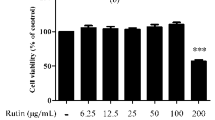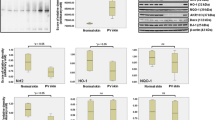Abstract
Hypoxia of skin is an important physiopathological process in many diseases, such as pressure ulcer, diabetic ulcer, and varicose ulcer. Although cellular injury and inflammation have been involved in hypoxia-induced dermatic injury, the underlying mechanisms remain largely unknown. This study was conducted to investigate the effects of cobalt chloride (CoCl2), a hypoxia-mimicking agent, on human skin keratinocytes (HaCaT cells) and to explore the possible molecular mechanisms. Exposure of HaCaT cells to CoCl2 reduced cell viability and caused overproduction of reactive oxygen species (ROS) and oversecretion of interleukin-6 (IL-6) and interleukin-8 (IL-8). Importantly, CoCl2 exposure elicited overexpression of cyclooxygenase-2 (COX-2) and phosphorylation of nuclear factor-kappa B (NF-κB) p65 subunit. Inhibition of COX-2 by NS-398, a selective inhibitor of COX-2, significantly repressed the cytotoxicity, as well as secretion of IL-6 and IL-8 induced by CoCl2. Inhibition of NF-κB by PDTC (a selective inhibitor of NF-κB) or genetic silencing of p65 by RNAi (Si-p65), attenuated not only the cytotoxicity and secretion of IL-6 and IL-8, but also overexpression of COX-2 in CoCl2-treated HaCaT cells. Neutralizing anti-IL-6 or anti-IL-8 antibody statistically alleviated CoCl2-induced cytotoxicity in HaCaT cells. N-acetyl-L-cysteine (NAC), a well characterized ROS scavenger, obviously suppressed CoCl2-induced cytotoxicity in HaCaT cells, as well as secretion of IL-6 and IL-8. Additionally, NAC also repressed overexpression of COX-2 and phosphorylation of NF- B κ p65 subunit induced by CoCl2 in HaCaT cells. In conclusion, our results demonstrated that oxidative stress mediates chemical hypoxia-induced injury and inflammatory response through activation of NF-κB-COX-2 pathway in HaCaT cells.
Similar content being viewed by others

References
Barcelos, L.S., Duplaa, C., Krankel, N., Graiani, G., Invernici, G., Katare, R., Siragusa, M., Meloni, M., Campesi, I., Monica, M., et al. (2009). Human CD133+ progenitor cells promote the healing of diabetic ischemic ulcers by paracrine stimulation of angiogenesis and activation of Wnt signaling. Circ. Res. 104, 1095–1102.
Birnbaum, Y., Ye, Y., Rosanio, S., Tavackoli, S., Hu, Z.Y., Schwarz, E.R., and Uretsky, B.F. (2005). Prostaglandins mediate the cardioprotective effects of atorvastatin against ischemia-reperfusion injury. Cardiovasc. Res. 65, 345–355.
Booth, E.A., Flint, R.R., Lucas, K.L., Knittel, A.K., and Lucchesi, B.R. (2008). Estrogen protects the heart from ischemia-reperfusion injury via COX-2-derived PGI2. J. Cardiovasc. Pharmacol. 52, 228–235.
Carnieto, A., Jr., Dourado, P.M., Luz, P.L., and Chagas, A.C. (2009). Selective cyclooxygenase-2 inhibition protects against myocardial damage in experimental acute ischemia. Clinics (Sao Paulo) 64, 245–252.
Chen, F., Castranova, V., Shi, X., and Demers, L.M. (1999). New insights into the role of nuclear factor-kappaB, a ubiquitous transcription factor in the initiation of diseases. Clin. Chem. 45, 7–17.
Chen, S.L., Yang, C.T., Yang, Z.L., Guo, R.X., Meng, J.L., Cui, Y., Lan, A.P., Chen, P.X., and Feng, J.Q. (2010). Hydrogen sulphide protects H9c2 cells against chemical hypoxia-induced injury. Clin. Exp. Pharmacol. Physiol. 37, 316–321.
Chi, Y.S., and Kim, H.P. (2005). Suppression of cyclooxygenase-2 expression of skin fibroblasts by wogonin, a plant flavone from Scutellaria radix. Prostaglandins Leukot. Essent. Fatty Acids 72, 59–66.
Dore, S., Otsuka, T., Mito, T., Sugo, N., Hand, T., Wu, L., Hurn, P. D., Traystman, R.J., and Andreasson, K. (2003). Neuronal overexpression of cyclooxygenase-2 increases cerebral infarction. Ann. Neurol. 54, 155–162.
Eidsmo, L., Fluur, C., Rethi, B., Eriksson Ygberg, S., Ruffin, N., De Milito, A., Akuffo, H., and Chiodi, F. (2007). FasL and TRAIL induce epidermal apoptosis and skin ulceration upon exposure to Leishmania major. Am. J. Pathol. 170, 227–239.
Ermolli, M., Menne, C., Pozzi, G., Serra, M.A., and Clerici, L.A. (2001). Nickel, cobalt and chromium-induced cytotoxicity and intracellular accumulation in human HaCaT keratinocytes. Toxicology 159, 23–31.
Fernau, N.S., Fugmann, D., Leyendecker, M., Reimann, K., Grether-Beck, S., Galban, S., Ale-Agha, N., Krutmann, J., and Klotz, L.O. (2010). Role of HuR and p38MAPK in ultraviolet B-induced posttranscriptional regulation of COX-2 expression in the human keratinocyte cell line HaCaT. J. Biol. Chem. 285, 3896–3904.
Gomez-Pinilla, P.J., Camello, P.J., Tresguerres, J.A., and Pozo, M.J. (2010). Tempol protects the gallbladder against ischemia/reperfusion. J. Physiol. Biochem. 66, 161–172.
Grimshaw, M.J., Naylor, S., and Balkwill, F.R. (2002). Endothelin-2 is a hypoxia-induced autocrine survival factor for breast tumor cells. Mol. Cancer Ther. 1, 1273–1281.
Houwing, R., Overgoor, M., Kon, M., Jansen, G., van Asbeck, B.S., and Haalboom, J.R. (2000). Pressure-induced skin lesions in pigs: reperfusion injury and the effects of vitamin E. J. Wound Care 9, 36–40.
Huang, C.Y., Fujimura, M., Noshita, N., Chang, Y.Y., and Chan, P.H. (2001). SOD1 down-regulates NF-kappaB and c-Myc expression in mice after transient focal cerebral ischemia. J. Cereb. Blood Flow Metab. 21, 163–173.
Ito, Y., Katagiri, H., Ishii, K., Kakita, A., Hayashi, I., and Majima, M. (2003). Effects of selective cyclooxygenase inhibitors on ischemia/reperfusion-induced hepatic microcirculatory dysfunction in mice. Eur. Surg. Res. 35, 408–416.
Jung, J.Y., and Kim, W.J. (2004). Involvement of mitochondrial- and Fas-mediated dual mechanism in CoCl2-induced apoptosis of rat PC12 cells. Neurosci. Lett. 371, 85–90.
Jung, J.Y., Mo, H.C., Yang, K.H., Jeong, Y.J., Yoo, H.G., Choi, N.K., Oh, W.M., Oh, H.K., Kim, S.H., Lee, J.H., et al. (2007). Inhibition by epigallocatechin gallate of CoCl2-induced apoptosis in rat PC12 cells. Life Sci. 80, 1355–1363.
Kang, Y.J., Wingerd, B.A., Arakawa, T., and Smith, W.L. (2006). Cyclooxygenase-2 gene transcription in a macrophage model of inflammation. J. Immunol. 177, 8111–8122.
Kim, K.S., Rajagopal, V., Gonsalves, C., Johnson, C., and Kalra, V.K. (2006). A novel role of hypoxia-inducible factor in cobalt chloride- and hypoxia-mediated expression of IL-8 chemokine in human endothelial cells. J. Immunol. 177, 7211–7224.
Kotake-Nara, E., and Saida, K. (2007). Characterization of CoCl2-induced reactive oxygen species (ROS): inductions of neurite outgrowth and endothelin-2/vasoactive intestinal contractor in PC12 cells by CoCl2 are ROS dependent, but those by MnCl2 are not. Neurosci. Lett. 422, 223–227.
Kotake-Nara, E., Takizawa, S., Quan, J., Wang, H., and Saida, K. (2005). Cobalt chloride induces neurite outgrowth in rat pheochromocytoma PC12 cells through regulation of endothelin-2/vasoactive intestinal contractor. J. Neurosci. Res. 81, 563–571.
Kwak, H.J., Park, K.M., Choi, H.E., Lim, H.J., Park, J.H., and Park, H.Y. (2010). The cardioprotective effects of zileuton, a 5-lipoxygenase inhibitor, are mediated by COX-2 via activation of PKC delta. Cell. Signal. 22, 80–87.
Lazarides, M.K., and Giannoukas, A.D. (2007). The role of hemodynamic measurements in the management of venous and ischemic ulcers. Int. J. Low. Extrem. Wounds 6, 254–261.
Li, B., Li, Y.M., Li, X., Shi, B., He, M.Y., Zhu, X.L., Zhou, W.C., Wachtel, M.S., and Frezza, E. (2009). COX-2 inhibition improves immune system homeostasis and decreases liver damage in septic rats. J. Surg. Res. 157, 43–47.
Liu, W., Reinmuth, N., Stoeltzing, O., Parikh, A.A., Tellez, C., Williams, S., Jung, Y.D., Fan, F., Takeda, A., Akagi, M., et al. (2003). Cyclooxygenase-2 is up-regulated by interleukin-1 beta in human colorectal cancer cells via multiple signaling pathways. Cancer Res. 63, 3632–3636.
Montopoli, M., Froldi, G., Comelli, M.C., Prosdocimi, M., and Caparrotta, L. (2007). Aescin protection of human vascular endothelial cells exposed to cobalt chloride mimicked hypoxia and inflammatory stimuli. Planta Med. 73, 285–288.
Mustoe, T.A., O’shaughnessy, K., and Kloeters, O. (2006). Chronic wound pathogenesis and current treatment strategies: a unifying hypothesis. Plast. Reconstr. Surg. 117, 35S–41S.
Nakayama, M., Uchimura, K., Zhu, R.L., Nagayama, T., Rose, M.E., Stetler, R.A., Isakson, P.C., Chen, J., and Graham, S.H. (1998). Cyclooxygenase-2 inhibition prevents delayed death of CA1 hippocampal neurons following global ischemia. Proc. Natl. Acad. Sci. USA 95, 10954–10959.
Oh, Y.T., Lee, J.Y., Lee, J., Lee, J.H., Kim, J.E., Ha, J., and Kang, I. (2010). Oleamide suppresses lipopolysaccharide-induced expression of iNOS and COX-2 through inhibition of NF-kappaB activation in BV2 murine microglial cells. Neurosci. Lett. 474, 148–153.
Peirce, S.M., Skalak, T.C., Rieger, J.M., Macdonald, T.L., and Linden, J. (2001). Selective A(2A) adenosine receptor activation reduces skin pressure ulcer formation and inflammation. Am. J. Physiol. Heart Circ. Physiol. 281, H67–74.
Pieper, G.M., Olds, C., Hilton, G., Lindholm, P.F., Adams, M.B., and Roza, A.M. (2001). Antioxidant treatment inhibits activation of myocardial nuclear factor kappa B and inhibits nitrosylation of myocardial heme protein in cardiac transplant rejection. Antioxid. Redox Signal. 3, 81–88.
Schmalz, G., Schweikl, H., and Hiller, K.A. (2000). Release of prostaglandin E2, IL-6 and IL-8 from human oral epithelial culture models after exposure to compounds of dental materials. Eur. J. Oral Sci. 108, 442–448.
Shibata, A., Nakagawa, K., Yamanoi, H., Tsuduki, T., Sookwong, P., Higuchi, O., Kimura, F., and Miyazawa, T. (2010). Sulforaphane suppresses ultraviolet B-induced inflammation in HaCaT keratinocytes and HR-1 hairless mice. J. Nutr. Biochem. 21, 702–709.
Shrivastava, A., and Aggarwal, B.B. (1999). Antioxidants differentially regulate activation of nuclear factor-kappa B, activator protein-1, c-jun amino-terminal kinases, and apoptosis induced by tumor necrosis factor: evidence that JNK and NF-kappa B activation are not linked to apoptosis. Antioxid. Redox Signal. 1, 181–191.
Talalay, P., Fahey, J.W., Healy, Z.R., Wehage, S.L., Benedict, A.L., Min, C., and Dinkova-Kostova, A.T. (2007). Sulforaphane mobilizes cellular defenses that protect skin against damage by UV radiation. Proc. Natl. Acad. Sci. USA 104, 17500–17505.
Tsutakawa, S., Kobayashi, D., Kusama, M., Moriya, T., and Nakahata, N. (2009). Nicotine enhances skin necrosis and expression of inflammatory mediators in a rat pressure ulcer model. Br. J. Dermatol. 161, 1020–1027.
Tu, X.K., Yang, W.Z., Shi, S.S., Wang, C.H., and Chen, C.M. (2009). Neuroprotective effect of baicalin in a rat model of permanent focal cerebral ischemia. Neurochem. Res. 34, 1626–1634.
Wagner, M., Klein, C.L., Kleinert, H., Euchenhofer, C., Forstermann, U., and Kirkpatrick, C.J. (1997). Heavy metal ion induction of adhesion molecules and cytokines in human endothelial cells: the role of NF-kappaB, I kappaB-alpha and AP-1. Pathobiology 65, 241–252.
Wagner, M., Klein, C.L., van Kooten, T.G., and Kirkpatrick, C.J. (1998). Mechanisms of cell activation by heavy metal ions. J. Biomed. Mater. Res. 42, 443–452.
Yun, Y., Duan, W.G., Chen, P., Wu, H.X., Shen, Z.Q., Qian, Z.Y., and Wang, D.H. (2009). Down-regulation of cyclooxygenase-2 is involved in ischemic postconditioning protection against renal ischemia reperfusion injury in rats. Transplant. Proc. 41, 3585–3589.
Zou, W., Yan, M., Xu, W., Huo, H., Sun, L., Zheng, Z., and Liu, X. (2001). Cobalt chloride induces PC12 cells apoptosis through reactive oxygen species and accompanied by AP-1 activation. J. Neurosci. Res. 64, 646–653.
Author information
Authors and Affiliations
Corresponding author
About this article
Cite this article
Yang, C., Ling, H., Zhang, M. et al. Oxidative stress mediates chemical hypoxia-induced injury and inflammation by activating NF-κb-COX-2 pathway in HaCaT cells. Mol Cells 31, 531–538 (2011). https://doi.org/10.1007/s10059-011-1025-3
Received:
Revised:
Accepted:
Published:
Issue Date:
DOI: https://doi.org/10.1007/s10059-011-1025-3



